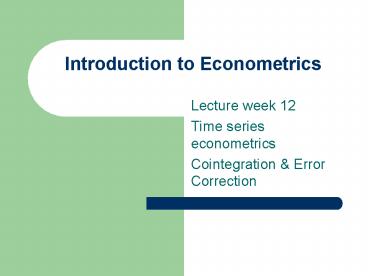Introduction to Econometrics - PowerPoint PPT Presentation
1 / 8
Title:
Introduction to Econometrics
Description:
A regression of one random walk series (nonstationary) on another random walk ... Augmented Engel-Granger test confirmed the presence of stable long-run ... – PowerPoint PPT presentation
Number of Views:27
Avg rating:3.0/5.0
Title: Introduction to Econometrics
1
Introduction to Econometrics
- Lecture week 12
- Time series econometrics
- Cointegration Error Correction
2
Cointegration
- A regression of one random walk series
(nonstationary) on another random walk series
gives a spurious regression b/c one of the basic
assumptions of the CLRM (i.e. time invariant
mean and variance of the error term) will be
violated. Exception to this is the case where the
series are cointegrated (i.e. the linear
combination of these series is stationary). - ut lagprot ?1 ?2lagprprice (t-1)
- If ut is stationary, lagpro lagprprice are
cointegrated i.e. there exists long-run
relationship between the variables. Thus, ?2 is
the cointegrating parameter. The regression is
not spurious. - If ut is not stationary, the variables are not
cointegrated. This means that the mean variance
of the residuals changes over time (i.e. the CLRM
assumptions are violated. Thus, the regression is
spurious. The solution in such cases is to remove
trends from the series through differencing. - Tests for cointegration Correlogram of the
residuals, augmented Engle-Granger (AEG) Test,
Cointegrating Regression Durbin-Watson (CRDW)
Test
3
Long-run equation a regression of LAGPRO on
LAGPRPRICE possible outlier detected in year 1972
4
Test for the significance of the outlier
confirmed overall result improved, outlier
removed
5
Test for cointegration cointegration confirmed
using augmented Engle-Granger Test (5 critical
is -3.78)
6
Conclusion on the cointegration test
- Augmented Engel-Granger test confirmed the
presence of stable long-run relationship between
the SAs agricultural production and SAs
producer price index. - The regression of agricultural production on
producer price is not spurious.
7
Error Correction Mechanism (ECM)
- The error term ut in the cointegration regression
is the equilibrium error. - The error correction mechanism corrects for
disequilibrium and serves as a link between the
short-run behavior of the dependent variable and
its long-run value. - If ?2 is statistically significant, it tells us
the proportion of disequilibrium in lagpro in one
period which is corrected in the next the larger
?2, the quicker the adjustment back to
equilibrium.
8
Error Correction Mechanism variables have the
expected sign, 64 of the disequilibrium in year
t-1 is corrected in year t.


























![[READ DOWNLOAD] The Effect: An Introduction to Research Design and Causality PowerPoint PPT Presentation](https://s3.amazonaws.com/images.powershow.com/10087195.th0.jpg?_=20240727042)
![get [PDF] Download The Effect: An Introduction to Research Design and Causality PowerPoint PPT Presentation](https://s3.amazonaws.com/images.powershow.com/10087196.th0.jpg?_=20240727042)
![[READ DOWNLOAD] The Effect: An Introduction to Research Design and Causality PowerPoint PPT Presentation](https://s3.amazonaws.com/images.powershow.com/10088344.th0.jpg?_=20240730019)
![get [PDF] Download The Effect: An Introduction to Research Design and Causality PowerPoint PPT Presentation](https://s3.amazonaws.com/images.powershow.com/10088345.th0.jpg?_=20240730019)

